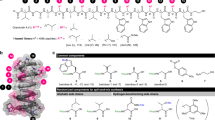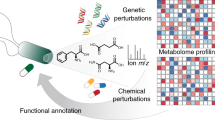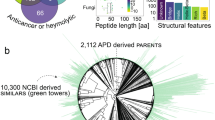Abstract
New techniques for systematic profiling of small-molecule effects can enhance traditional growth inhibition screens for antibiotic discovery and change how we search for new antibacterial agents. Computational models that integrate physicochemical compound properties with their phenotypic and molecular downstream effects can not only predict efficacy of molecules yet to be tested, but also reveal unprecedented insights on compound modes of action (MoAs). The unbiased characterization of compounds that themselves are not growth inhibitory but exhibit diverse MoAs, can expand antibacterial strategies beyond direct inhibition of core essential functions. Early and systematic functional annotation of compound libraries thus paves the way to new models in the selection of lead antimicrobial compounds. In this Review, we discuss how multidimensional small-molecule profiling and the ever-increasing computing power are accelerating the discovery of unconventional antibacterials capable of bypassing resistance and exploiting synergies with established antibacterial treatments and with protective host mechanisms.

This is a preview of subscription content, access via your institution
Access options
Access Nature and 54 other Nature Portfolio journals
Get Nature+, our best-value online-access subscription
$29.99 / 30 days
cancel any time
Subscribe to this journal
Receive 12 print issues and online access
$259.00 per year
only $21.58 per issue
Buy this article
- Purchase on Springer Link
- Instant access to full article PDF
Prices may be subject to local taxes which are calculated during checkout





Similar content being viewed by others
References
Cox, G. et al. A common platform for antibiotic dereplication and adjuvant discovery. Cell Chem. Biol. 24, 98–109 (2017).
Beckley, A. M. & Wright, E. S. Identification of antibiotic pairs that evade concurrent resistance via a retrospective analysis of antimicrobial susceptibility test results. Lancet Microbe 2, e545–e554 (2021).
Bosch, B. et al. Genome-wide gene expression tuning reveals diverse vulnerabilities of M. tuberculosis. Cell 184, 4579–4592.e24 (2021). Systematic titration of gene expression and analysis of fitness cost in Mycobacterium tuberculosis reveals genes vulnerability and quantify essentiality of bacterial functions.
Johnson, E. O. et al. Large-scale chemical–genetics yields new M. tuberculosis inhibitor classes. Nature 571, 72–78 (2019). Elegant strategy to screen large chemical libraries against hypomorph pools of strains depleted of essential bacterial targets.
Pethe, K. et al. A chemical genetic screen in Mycobacterium tuberculosis identifies carbon-source-dependent growth inhibitors devoid of in vivo efficacy. Nat. Commun. 1, 57 (2010).
Brown, D. G., May-Dracka, T. L., Gagnon, M. M. & Tommasi, R. Trends and exceptions of physical properties on antibacterial activity for Gram-positive and Gram-negative pathogens. J. Med. Chem. 57, 10144–10161 (2014).
Smith, P. A. et al. Optimized arylomycins are a new class of Gram-negative antibiotics. Nature 561, 189–194 (2018).
Richter, M. F. et al. Predictive compound accumulation rules yield a broad-spectrum antibiotic. Nature 545, 299–304 (2017).
Gautam, U. S., Sikri, K., Vashist, A., Singh, V. & Tyagi, J. S. Essentiality of DevR/DosR interaction with SigA for the dormancy survival program in Mycobacterium tuberculosis. J. Bacteriol. 196, 790–799 (2014).
Hung, D. T., Shakhnovich, E. A., Pierson, E. & Mekalanos, J. J. Small-molecule inhibitor of Vibrio cholerae virulence and intestinal colonization. Science https://doi.org/10.1126/science.1116739 (2005).
Larkins-Ford, J. et al. Systematic measurement of combination-drug landscapes to predict in vivo treatment outcomes for tuberculosis. Cell Syst. 12, 1046–1063.e7 (2021).
Stokes, J. M. et al. A deep learning approach to antibiotic discovery. Cell 180, 688–702.e13 (2020). The authors developed a deep-learning model trained to predict antibiotics based on structure and in vitro growth inhibitory activity, identifying a molecule that exhibits broad-spectrum antibiotic activities in mice.
Ding, T. et al. Predicting essential metabolic genome content of niche-specific enterobacterial human pathogens during simulation of host environments. PLoS ONE 11, e0149423 (2016).
Zampieri, M. et al. High-throughput metabolomic analysis predicts mode of action of uncharacterized antimicrobial compounds. Sci. Transl. Med. 10, eaal3973 (2018). Combination of high-throughput metabolic profiling of chemical libraries and limited proteolysis reveal the modes of action of new antituberculosis compounds.
Messner, C. B. et al. Ultra-fast proteomics with Scanning SWATH. Nat. Biotechnol. https://doi.org/10.1038/s41587-021-00860-4 (2021). By combining SWATH technology with high-flow chromatography, the authors developed an ultra-fast proteomics approach to reduce sample acquisition measurements to 60 s, providing new opportunities in drug mode-of-action screening.
Ye, C. et al. DRUG-seq for miniaturized high-throughput transcriptome profiling in drug discovery. Nat. Commun. 9, 4307 (2018).
Stokes, J. M. et al. A multiplexable assay for screening antibiotic lethality against drug-tolerant bacteria. Nat. Methods 16, 303–306 (2019).
French, S., Coutts, B. E. & Brown, E. D. Open-source high-throughput phenomics of bacterial promoter-reporter strains. Cell Syst. 7, 339–346.e3 (2018).
Wawer, M. J. et al. Toward performance-diverse small-molecule libraries for cell-based phenotypic screening using multiplexed high-dimensional profiling. Proc. Natl Acad. Sci. USA 111, 10911–10916 (2014).
Peters, J. M. et al. A comprehensive, CRISPR-based functional analysis of essential genes in bacteria. Cell 165, 1493–1506 (2016).
O’Rourke, A. et al. Mechanism-of-action classification of antibiotics by global transcriptome profiling. Antimicrob. Agents Chemother. 64, e01207–e01219 (2020).
Zoffmann, S. et al. Machine learning-powered antibiotics phenotypic drug discovery. Sci. Rep. 9, 5013 (2019). This study comprehensively demonstrates the power of combining multiparametric highcontent screening and genomic approaches, beyond classical susceptibility screening, to guide lead compound selection and their functional annotation.
Melo, M. C. R., Maasch, J. R. M. A. & de la Fuente-Nunez, C. Accelerating antibiotic discovery through artificial intelligence. Commun. Biol. 4, 1050 (2021).
Rousset, F. et al. The impact of genetic diversity on gene essentiality within the Escherichia coli species. Nat. Microbiol. 6, 301–312 (2021).
Andrew, J. H., Wale, M. C., Wale, L. J. & Greenwood, D. The effect of cultural conditions on the activity of LY146032 against staphylococci and streptococci. J. Antimicrob. Chemother. 20, 213–221 (1987).
Belanger, C. R. et al. Identification of novel targets of azithromycin activity against Pseudomonas aeruginosa grown in physiologically relevant media. Proc. Natl Acad. Sci. USA 117, 33519–33529 (2020).
Low, L. A., Mummery, C., Berridge, B. R., Austin, C. P. & Tagle, D. A. Organs-on-chips: into the next decade. Nat. Rev. Drug Discov. 20, 345–361 (2021).
Mateus, A. et al. Thermal proteome profiling in bacteria: probing protein state in vivo. Mol. Syst. Biol. 14, e8242 (2018).
Piazza, I. et al. A machine learning-based chemoproteomic approach to identify drug targets and binding sites in complex proteomes. Nat. Commun. 11, 4200 (2020).
Jumper, J. et al. Highly accurate protein structure prediction with AlphaFold. Nature 596, 583–589 (2021).
Gainza, P. et al. Deciphering interaction fingerprints from protein molecular surfaces using geometric deep learning. Nat. Methods 17, 184–192 (2020).
Martin, J. K. et al. A dual-mechanism antibiotic kills Gram-negative bacteria and avoids drug resistance. Cell 181, 1518–1532.e14 (2020).
Jiang, W., Oikonomou, P. & Tavazoie, S. Comprehensive genome-wide perturbations via CRISPR adaptation reveal complex genetics of antibiotic sensitivity. Cell 180, 1002–1017.e31 (2020).
Palmer, A. C. & Kishony, R. Opposing effects of target overexpression reveal drug mechanisms. Nat. Commun. 5, 4296 (2014).
Nonejuie, P., Burkart, M., Pogliano, K. & Pogliano, J. Bacterial cytological profiling rapidly identifies the cellular pathways targeted by antibacterial molecules. Proc. Natl Acad. Sci. USA 110, 16169–16174 (2013).
Zheng, H. et al. Inhibitors of Mycobacterium tuberculosis DosRST signaling and persistence. Nat. Chem. Biol. 13, 218–225 (2017).
Claudi, B. et al. Phenotypic variation of Salmonella in host tissues delays eradication by antimicrobial chemotherapy. Cell 158, 722–733 (2014).
Campos, A. I. & Zampieri, M. Metabolomics-driven exploration of the chemical drug space to predict combination antimicrobial therapies. Mol. Cell 74, 1291–1303.e6 (2019). Comparing metabolic changes induced by genetic and chemical perturbations can be used to characterize MoAs of compounds that target non-essential processes and thereby enable searches for unconventional antibacterial compounds.
Imai, Y. et al. A new antibiotic selectively kills Gram-negative pathogens. Nature 576, 459–464 (2019).
Subramanian, A. et al. A next generation connectivity map: L1000 platform and the first 1,000,000 profiles. Cell 171, 1437–1452.e17 (2017).
Imdahl, F., Vafadarnejad, E., Homberger, C., Saliba, A.-E. & Vogel, J. Single-cell RNA-sequencing reports growth-condition-specific global transcriptomes of individual bacteria. Nat. Microbiol. 5, 1202–1206 (2020).
Madhukar, N. S. et al. A Bayesian machine learning approach for drug target identification using diverse data types. Nat. Commun. 10, 5221 (2019).
di Bernardo, D. et al. Chemogenomic profiling on a genome-wide scale using reverse-engineered gene networks. Nat. Biotechnol. 23, 377–383 (2005).
Das, P. et al. Accelerated antimicrobial discovery via deep generative models and molecular dynamics simulations. Nat. Biomed. Eng. https://doi.org/10.1038/s41551-021-00689-x (2021).
Moret, N. et al. Cheminformatics tools for analyzing and designing optimized small-molecule collections and libraries. Cell Chem. Biol. 26, 765–777.e3 (2019).
Widya, M. et al. Development and optimization of a higher-throughput bacterial compound accumulation assay. ACS Infect. Dis. 5, 394–405 (2019).
Yang, J. H. et al. A white-box machine learning approach for revealing antibiotic mechanisms of action. Cell 177, 1649–1661.e9 (2019).
Senges, C. H. R. et al. Comparison of proteomic responses as global approach to antibiotic mechanism of action elucidation. Antimicrob. Agents Chemother. 65, e01373–20 (2020).
Sastry, A. V. et al. Independent component analysis recovers consistent regulatory signals from disparate datasets. PLoS Comput. Biol. 17, e1008647 (2021).
Patel-Murray, N. L. et al. A multi-omics interpretable machine learning model reveals modes of action of small molecules. Sci. Rep. 10, 954 (2020).
Kwon, Y. K. et al. A domino effect in antifolate drug action in Escherichia coli. Nat. Chem. Biol. 4, 602–608 (2008).
Li, A. et al. Multi-omic analyses provide links between low-dose antibiotic treatment and induction of secondary metabolism in Burkholderia thailandensis. mBio https://doi.org/10.1038/s41551-021-00689-x (2020).
Freiberg, C., Fischer, H. P. & Brunner, N. A. Discovering the mechanism of action of novel antibacterial agents through transcriptional profiling of conditional mutants. Antimicrob. Agents Chemother. 49, 749–759 (2005).
Zhong, F. et al. Drug target inference by mining transcriptional data using a novel graph convolutional network framework. Protein Cell https://doi.org/10.1007/s13238-021-00885-0 (2021).
Anglada-Girotto, M. et al. Combining CRISPRi and metabolomics for functional annotation of compound libraries. Nat. Chem. Biol. https://doi.org/10.1038/s41589-022-00970-3 (2022).
Donati, S. et al. Multi-omics analysis of CRISPRi-knockdowns identifies mechanisms that buffer decreases of enzymes in E. coli metabolism. Cell Syst. https://doi.org/10.1016/j.cels.2020.10.011 (2020). Model-based regulatory analysis of metabolic adaptive changes after gene knockdowns revealed regulatory mechanisms that can buffer fluctuations in enzyme protein levels.
Christodoulou, D. et al. Reserve flux capacity in the pentose phosphate pathway enables Escherichia coli’s rapid response to oxidative stress. Cell Syst. 6, 569–578.e7 (2018).
Noh, H., Shoemaker, J. E. & Gunawan, R. Network perturbation analysis of gene transcriptional profiles reveals protein targets and mechanism of action of drugs and influenza A viral infection. Nucleic Acids Res. 46, e34 (2018).
Gardner, T. S., Bernardo, D., di, Lorenz, D. & Collins, J. J. Inferring genetic networks and identifying compound mode of action via expression profiling. Science 301, 102–105 (2003).
Shaw, D., Hermoso, A., Lluch-Senar, M. & Serrano, L. Comparative gene essentiality across the bacterial domain. Preprint at bioRxiv https://doi.org/10.1101/2020.02.28.969238 (2020).
Bakheet, T. M. & Doig, A. J. Properties and identification of antibiotic drug targets. BMC Bioinf. 11, 195 (2010).
Kauppi, A. M., Nordfelth, R., Uvell, H., Wolf-Watz, H. & Elofsson, M. Targeting bacterial virulence: inhibitors of type III secretion in Yersinia. Chem. Biol. 10, 241–249 (2003).
Dong, Y. H. et al. Quenching quorum-sensing-dependent bacterial infection by an N-acyl homoserine lactonase. Nature 411, 813–817 (2001).
Gifford, A. H. et al. Use of a multiplex transcript method for analysis of Pseudomonas aeruginosa gene expression profiles in the cystic fibrosis lung. Infect. Immun. 84, 2995–3006 (2016).
Budzik, J. M. et al. Dynamic post-translational modification profiling of Mycobacterium tuberculosis-infected primary macrophages. eLife 9, e51461 (2020).
Ejim, L. et al. Combinations of antibiotics and nonantibiotic drugs enhance antimicrobial efficacy. Nat. Chem. Biol. 7, 348–350 (2011).
Rustad, T. R. et al. Mapping and manipulating the Mycobacterium tuberculosis transcriptome using a transcription factor overexpression-derived regulatory network. Genome Biol. 15, 502 (2014).
Bina, J. et al. ToxR regulon of Vibrio cholerae and its expression in vibrios shed by cholera patients. Proc. Natl Acad. Sci. USA 100, 2801–2806 (2003).
Rosenberg, G. et al. Host succinate is an activation signal for Salmonella virulence during intracellular infection. Science https://doi.org/10.1126/science.aba8026 (2021).
Tattoli, I. et al. Amino acid starvation induced by invasive bacterial pathogens triggers an innate host defense program. Cell Host Microbe 11, 563–575 (2012).
Barber, M. F. & Elde, N. C. Escape from bacterial iron piracy through rapid evolution of transferrin. Science 346, 1362–1366 (2014).
Baran, R. et al. Metabolic footprinting of mutant libraries to map metabolite utilization to genotype. ACS Chem. Biol. 8, 189–199 (2013).
Øyås, O. et al. Model-based integration of genomics and metabolomics reveals SNP functionality in Mycobacterium tuberculosis. Proc. Natl. Acad. Sci. USA https://doi.org/10.1073/pnas.1915551117 (2020).
Bartell, J. A. et al. Reconstruction of the metabolic network of Pseudomonas aeruginosa to interrogate virulence factor synthesis. Nat. Commun. 8, 14631 (2017).
Großeholz, R. et al. Integrating highly quantitative proteomics and genome-scale metabolic modeling to study pH adaptation in the human pathogen Enterococcus faecalis. NPJ Syst. Biol. Appl. 2, 16017 (2016).
Bordbar, A., Lewis, N. E., Schellenberger, J., Palsson, B. O. & Jamshidi, N. Insight into human alveolar macrophage and M. tuberculosis interactions via metabolic reconstructions. Mol. Syst. Biol. 6, 422 (2010).
Zimmermann, M. et al. Integration of metabolomics and transcriptomics reveals a complex diet of Mycobacterium tuberculosis during early macrophage infection. mSystems 2, e00057-07 (2017).
Sarigul, N., Korkmaz, F. & Kurultak, İ. A new artificial urine protocol to better imitate human urine. Sci. Rep. 9, 20159 (2019).
Fernández-García, M. et al. Comprehensive examination of the mouse lung metabolome following Mycobacterium tuberculosis infection using a multiplatform mass spectrometry approach. J. Proteome Res. 19, 2053–2070 (2020).
Zlitni, S., Ferruccio, L. F. & Brown, E. D. Metabolic suppression identifies new antibacterial inhibitors under nutrient limitation. Nat. Chem. Biol. 9, 796–804 (2013).
Hasenoehrl, E. J. et al. Derailing the aspartate pathway of Mycobacterium tuberculosis to eradicate persistent infection. Nat. Commun. 10, 4215 (2019).
Raby, A.-C. et al. Targeting the TLR co-receptor CD14 with TLR2-derived peptides modulates immune responses to pathogens. Sci. Transl. Med. 5, 185ra64–185ra64 (2013).
Ma, S. et al. Transcriptional regulator-induced phenotype screen reveals drug potentiators in Mycobacterium tuberculosis. Nat. Microbiol. 6, 44–50 (2021).
Stokes, J. M. et al. Pentamidine sensitizes Gram-negative pathogens to antibiotics and overcomes acquired colistin resistance. Nat. Microbiol. 2, 17028 (2017).
Chandrasekaran, S. et al. Chemogenomics and orthology‐based design of antibiotic combination therapies. Mol. Syst. Biol. 12, 872 (2016).
Lukačišin, M. & Bollenbach, T. Emergent gene expression responses to drug combinations predict higher-order drug interactions. Cell Syst. 9, 423–433.e3 (2019).
Ma, S. et al. Transcriptomic signatures predict regulators of drug synergy and clinical regimen efficacy against tuberculosis. mBio 10, e02627–19 (2019). The authors used a machine learning approach to screen in silico more than 1 million potential drug combinations using Mycobacterium tuberculosis transcriptomic profiles of individual drug effects, resulting mechanistic insights on drug–drug interactions.
Lopatkin, A. J. et al. Clinically relevant mutations in core metabolic genes confer antibiotic resistance. Science 371, eaba0862 (2021).
Schrader, S. M. et al. Multiform antimicrobial resistance from a metabolic mutation. Sci. Adv. 7, eabh2037 (2021).
Weis, C. et al. Direct antimicrobial resistance prediction from clinical MALDI–TOF mass spectra using machine learning. Nat. Med. https://doi.org/10.1038/s41591-021-01619-9 (2022).
Zampieri, M. et al. Metabolic constraints on the evolution of antibiotic resistance. Mol. Syst. Biol. 13, 917 (2017).
Stone, L. K. et al. Compounds that select against the tetracycline-resistance efflux pump. Nat. Chem. Biol. 12, 902–904 (2016).
Blondiaux, N. et al. Reversion of antibiotic resistance in Mycobacterium tuberculosis by spiroisoxazoline SMARt-420. Science 355, 1206–1211 (2017).
Khaledi, A. et al. Predicting antimicrobial resistance in Pseudomonas aeruginosa with machine learning-enabled molecular diagnostics. EMBO Mol. Med. 12, e10264 (2020).
Dunphy, L. J., Yen, P. & Papin, J. A. Integrated experimental and computational analyses reveal differential metabolic functionality in antibiotic-resistant Pseudomonas aeruginosa. Cell Syst. 8, e3 (2019).
Santi, I., Manfredi, P., Maffei, E., Egli, A. & Jenal, U. Evolution of antibiotic tolerance shapes resistance development in chronic Pseudomonas aeruginosa infections. mBio 12, e03482–20 (2021).
Van den Bergh, B. et al. Frequency of antibiotic application drives rapid evolutionary adaptation of Escherichia coli persistence. Nat. Microbiol. 1, 1–7 (2016).
Maynard, A. et al. Antibiotic Korormicin A kills bacteria by producing reactive oxygen species. J. Bacteriol. 201, e00718–e00718 (2019).
Liu, J., Gefen, O., Ronin, I., Bar-Meir, M. & Balaban, N. Q. Effect of tolerance on the evolution of antibiotic resistance under drug combinations. Science 367, 200–204 (2020).
Duran-Frigola, M. et al. Extending the small-molecule similarity principle to all levels of biology with the Chemical Checker. Nat. Biotechnol. https://doi.org/10.1038/s41587-020-0502-7 (2020).
Acknowledgements
We thank N. de Souza, J. Sollier and M. Berney for helpful feedbacks and discussions. This work was supported by the National Center of Competence in Research AntiResist funded by the Swiss National Science Foundation (grant no. 180541) to M.Z., SNF Sinergia grant no. CRSII5_189952 to M.Z and the Swiss Cancer League (KLS 4124-02-2017) to M.Z. and K.O.
Author information
Authors and Affiliations
Corresponding author
Ethics declarations
Competing interests
The authors declare no competing interests.
Peer review
Peer review information
Nature Chemical Biology thanks Sriram Chandresekaran, Allison Lopatkin and the other, anonymous, reviewer(s) for their contribution to the peer review of this work.
Additional information
Publisher’s note Springer Nature remains neutral with regard to jurisdictional claims in published maps and institutional affiliations.
Rights and permissions
About this article
Cite this article
Ortmayr, K., de la Cruz Moreno, R. & Zampieri, M. Expanding the search for small-molecule antibacterials by multidimensional profiling. Nat Chem Biol 18, 584–595 (2022). https://doi.org/10.1038/s41589-022-01040-4
Received:
Accepted:
Published:
Issue Date:
DOI: https://doi.org/10.1038/s41589-022-01040-4
This article is cited by
-
Antimicrobial resistance crisis: could artificial intelligence be the solution?
Military Medical Research (2024)



